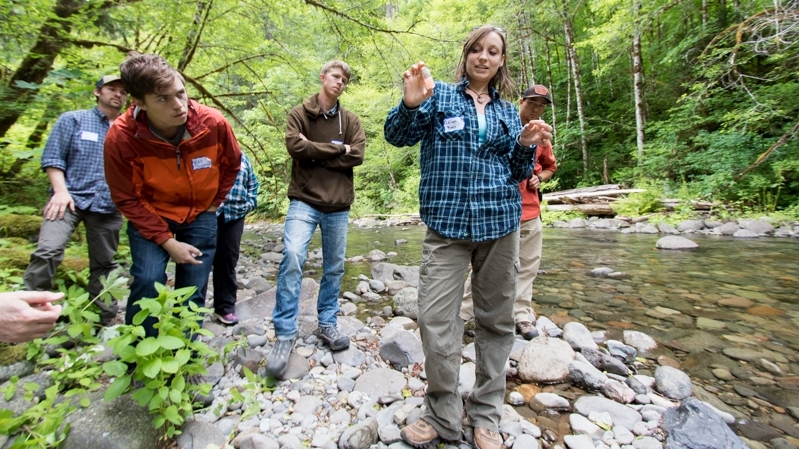Research Experience for Teachers (RET)
The Research Experience for Teachers (RET) program matches K-12 teachers with scientists for 8-10 weeks of field data collection and independent research. The RET program is funded by the National Science Foundation.
Past Research Experience for Teachers at the Andrews Forest
Whitney Davis and James Stoe
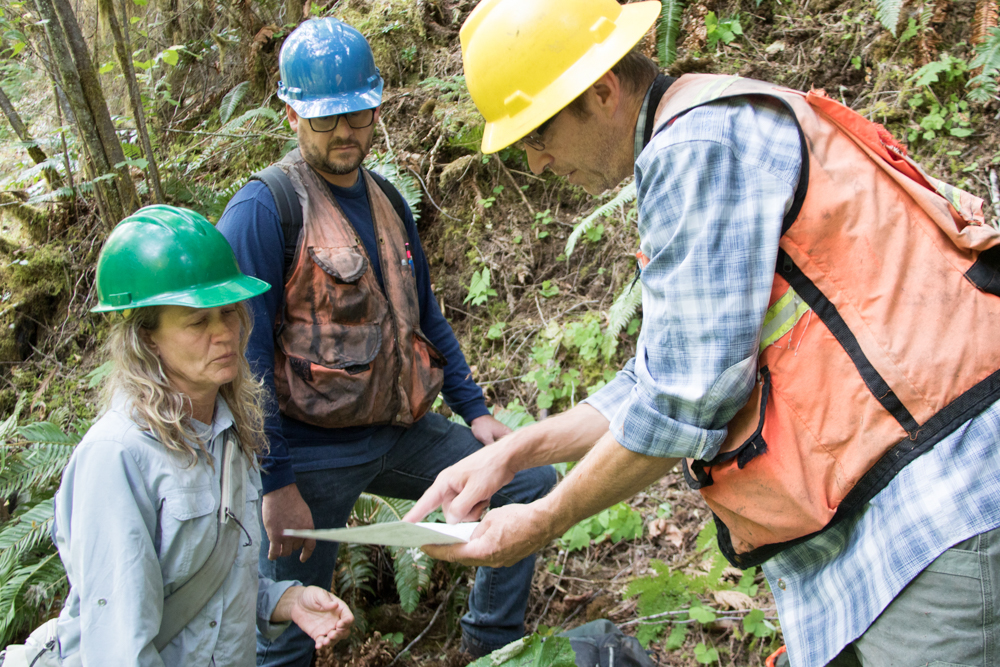 Whitney Davis and James Stoe teach science at Fern Ridge Middle School, which is in a rural community west of Eugene, Oregon. In 2021, Whitney and James worked with Dr. Mark Schulze and Dr. Adam Sibley on research about the influence of drought and heat stress on tree growth and overall forest productivity. The RET fellows conducted a research project that examined the influence of the June 2021 extreme heat wave on Douglas-fir and Western hemlock needles, using an imaging fluorometer to measure indices of photosynthetic function on surviving needles from branches experiencing heat scorch. They contributed to long-term study of tree growth responses to drought stress, installing dendrometer bands along the Discovery Trail and in a dry forest site nearby, which will be used by researchers and students to look at seasonal and daily patterns of stem water ba;ance and growth. They also remeasured permanent forest plots in the Discovery Trail education area. For their education project, the two RETs developed a forest dynamics protocol for use by middle school students on field trips to the HJA LTER site. James and Whitney will work closely with the Environmental Leadership Program undergraduate students at the University of Oregon who will lead the middle school field trips using the protocols that Whitney and James developed. See images of their field work at https://andrewsforest.oregonstate.edu/gallery/research-experience-teachers-ret-2021
Whitney Davis and James Stoe teach science at Fern Ridge Middle School, which is in a rural community west of Eugene, Oregon. In 2021, Whitney and James worked with Dr. Mark Schulze and Dr. Adam Sibley on research about the influence of drought and heat stress on tree growth and overall forest productivity. The RET fellows conducted a research project that examined the influence of the June 2021 extreme heat wave on Douglas-fir and Western hemlock needles, using an imaging fluorometer to measure indices of photosynthetic function on surviving needles from branches experiencing heat scorch. They contributed to long-term study of tree growth responses to drought stress, installing dendrometer bands along the Discovery Trail and in a dry forest site nearby, which will be used by researchers and students to look at seasonal and daily patterns of stem water ba;ance and growth. They also remeasured permanent forest plots in the Discovery Trail education area. For their education project, the two RETs developed a forest dynamics protocol for use by middle school students on field trips to the HJA LTER site. James and Whitney will work closely with the Environmental Leadership Program undergraduate students at the University of Oregon who will lead the middle school field trips using the protocols that Whitney and James developed. See images of their field work at https://andrewsforest.oregonstate.edu/gallery/research-experience-teachers-ret-2021
Eric Beck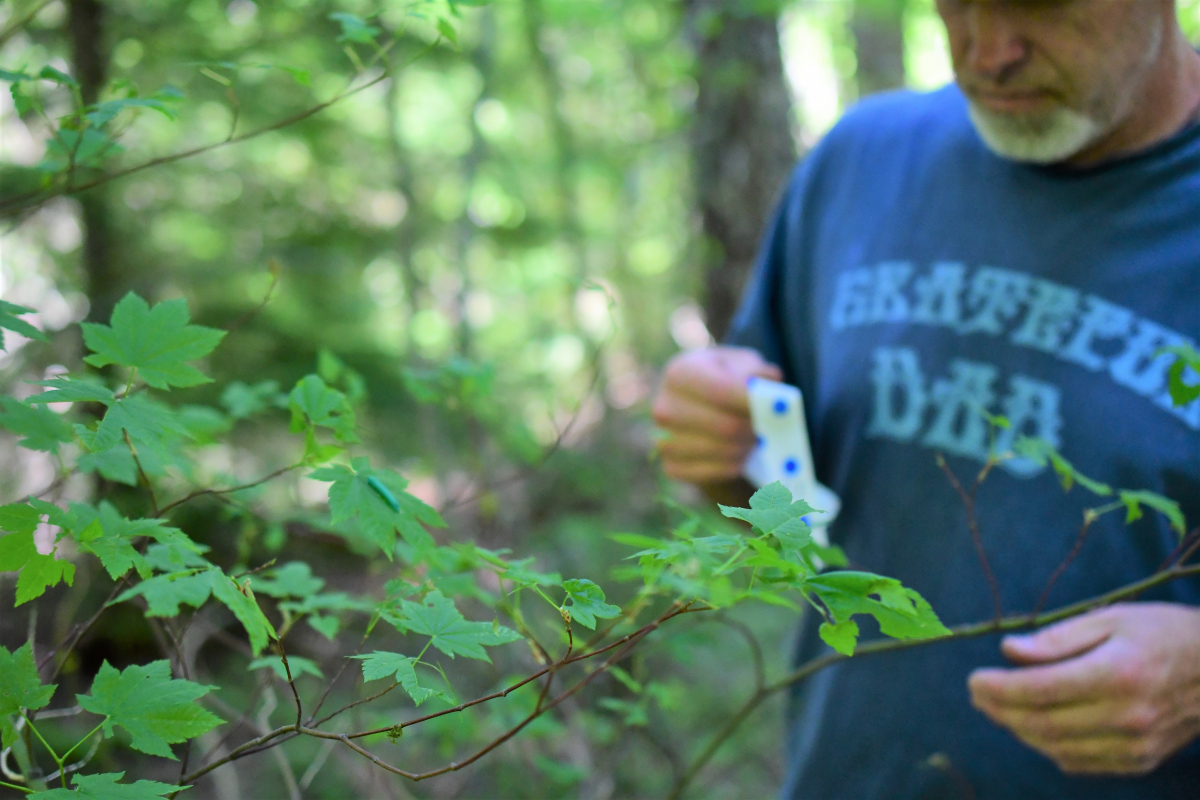
Eric Beck teaches 7th & 8th-grade science at Realms Middle School in Bend, Oregon. He worked with Andrews Forest LTER scientists Hankyu Kim and Matt Betts on their research about bird distributions and microclimate. As part of his RET fellowship, Beck co-led (along with RET Jake Zywicke) his own study about predator-caterpillar dynamics, caught and banded birds, took part in a bird point count, and observed Spotted Owls. Beck implemented a predator-caterpillar dynamics study with his 7th-grade students and built in bird identification through songs and calls into an existing unit on birds. One of Beck’s lesson plan is online as a Data Nugget about birds and habitat: Trees and bushes, home sweet home for warblers.
Jake Zywicke
Jake Zywicke teaches 6th-grade science at Realms Middle School in Bend, Oregon. He worked with Andrews Forest LTER scientists Hankyu Kim and Matt Betts on their research about bird distributions and microclimate. As part of his RET fellowship, Zywicke co-led (along with RET Eric Beck) his own study about predator-caterpillar dynamics, caught and banded birds, took part in a bird point count, and observed Spotted Owls. During the 2019-20 school year, Zywicke implemented a phenology project with his 6th-grade students and connected it to Andrews Forest LTER long-term phenology datasets.
Nate Day and Corey Culp
We engaged two Research Experience for Teachers (RET) fellows the summer of 2018. Nate Day and Corey Culp teach science and business and technology, respectively, at McKenzie High School, the high school closest to the Andrews Forest LTER site. They worked with Andrews Forest LTER scientist Dana Warren and graduate student Allison Swartz on research examining the impact of canopy removal on structure and function of aquatic systems. Mr. Culp applied his RET experience in his Exploring Computer Science course. He developed a unit focused on data management using data collected by Day’s students in his science classes. Day applied his RET experience through the development of phenology learning activities and a field trip to the Andrews Forest. Day brought his students to the Andrews Forest where they participated in a phenology data collection session and engaged in a poster review gallery walk there. The same students then set up a phenology trail at their school modeled after the phenology trail that is part of the Andrews Forest Discovery Trail and led fourth-grade students on the trail.
Leilagh Boyle
Leilagh Boyle teaches Environmental Studies, Biology, and AP Biology, respectively, at Cottage Grove High School, a Title I school one hour from the H.J. Andrews Experimental Forest LTER site. In 2016, she and fellow Cottage Grove high school teacher Jessica Flood (see below) worked with Ivan Arismendi, Alba Argerich, and Brooke Penaluna on research about the structure and function of aquatic systems at the Andrews LTER site. During the 2016-17 school year, Ms. Boyle led her environmental studies students in several field investigations based on her RET experience including a stream ecology survey, a controlled experiment to test the effect of tile color on algal growth, and an investigation of the role of stream microorganisms in photosynthesis. One of Leilagh's lesson plans is now online as a "Data Nugget" titled "All washed up? The effect of floods on cutthroat trout."
Jessica Flood
Jessica Flood teaches Geometry and Applied Technical Math and Environmental Studies at Cottage Grove High School, a Title I school one hour from the H.J. Andrews Experimental Forest LTER site. In 2016, she and fellow Cottage Grove high school teacher Leilagh Boyle (see above) worked with Ivan Arismendi, Alba Argerich, and Brooke Penaluna on research about the structure and function of aquatic systems at the Andrews Forest LTER site. During the 2016-17 school year, Flood created lessons for her Algebra 2 students that used real data collected from an experiment examining the influence of fish on stream metabolism, a project on which Ms. Boyle and Ms. Flood worked on with Andrews LTER REU Francisco Tinoco Pickens. The Algebra 2 students started by modeling the data with graphs and equations, then making predictions based on the relationship they investigated and finally judging the reasonableness of their predictions in the context of the data.
 Jeremy Magee
Jeremy Magee
Jeremy Magee teaches biology, physical science, and AP environmental science to 9-12 grade students at Sandy High school in Sandy, Oregon. In 2013, he worked with the Bunchgrass Ridge Restoration project led by Dr. Charlie Halpern of University of Washington. Magee worked alongside graduate students, a postdoctoral researcher, two students in NSF's Research Assistantships for High School Students (RAHSS) Program, an undergraduate in NSF's Research Experience for Undergraduates (REU) Program, a French student intern, and a USFS summer employee to complete a year-8 remeasurement of tree-removal plots treated with or without fire, and adjacent "reference" meadows, as part of an unusually detailed and long-running restoration experiment in high-mountain meadows. The study is part of the critical partnership between Andrews Forest LTER researchers and the Willamette National Forest, which has been a vital partner in conducting this study, a user of the resulting information, and a champion of outreach to other land managers. In the fall of 2013, Magee led his students in using field and analysis techniques from the Bunchgrass Ridge project to compare biodiversity of a forest and urban meadow habitat. He also highlighted the Bunchgrass Ridge project as an example of the scientific method/process in practice. Visit the Bunchgrass Ridge webpage to learn more about their research, education, and training opportunities.
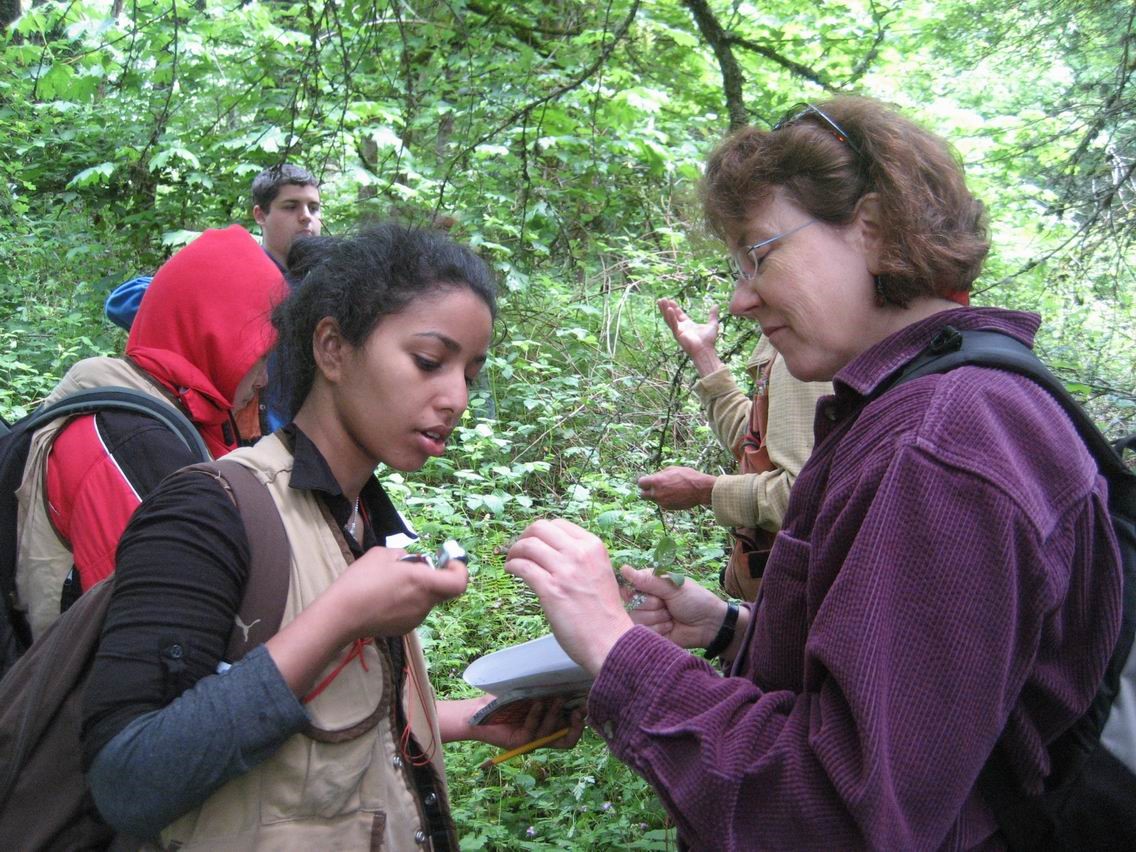 Jill Semlick
Jill Semlick
Jill Semlick teaches 9th and 10th grade biology to a high-minority (61%) and low socio-economic status (64% free & reduced lunch) population of students at Madison High School in Portland. In 2012, she worked with Andrews Forest scientists on the long-term phenology project to get ideas for involving her students in similar field-based inquiry. In the fall of 2012, she guided her 11th and 12th-grade students in her Sustainable Agriculture class in a study of insect diversity using pitfall traps and led her freshman biology students and summer school students in a decomposition study as part of collaboration with the Israeli LTER site. Click here to see a video that Ms. Semlick and Ms. Luftig made about how to make and install simple pitfall traps for use with student field investigations.
 Brian Vollmer-Buhl
Brian Vollmer-Buhl
Brian Vollmer-Buhl teaches biology, life science, earth science, oceanography, forensic science, chemistry, and physics in grades 7-12 in Mapleton, a small rural community located in the coast range, 40 miles west of Eugene. In 2012, he worked with Andrews Forest scientists on the long-term phenology project, long-term watershed program, and a high-elevation pollinator study with the goal of learning current scientific methodologies that his students can apply to their yearly science inquiry project. Vollmer-Buhl guided his general biology students in conducting a diversity study of the invertebrates at six different locations/habitats on the school grounds. Students set up and collected invertebrates from pitfall and flying beetle traps, both collection methods that Brian learned about in the long-term phenology study. Students learned about dichotomous keys, identified the invertebrates they collected, and presented their analysis as a final project for the year.
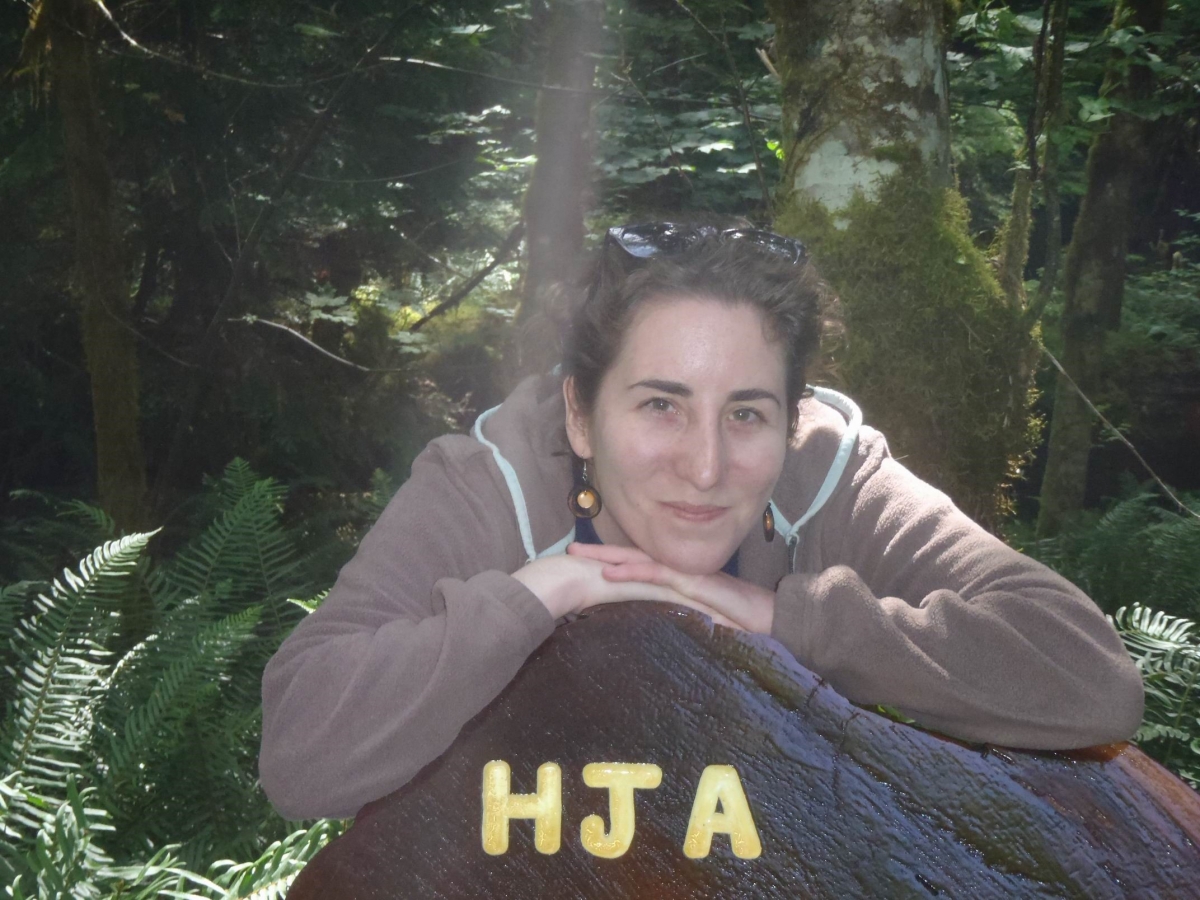 Alexandria Luftig
Alexandria Luftig
Alexandria Luftig taught anatomy and physiology and biophysical foundations (9th grade science) at Corvallis high school. In 2012, she worked with all sides of the phenology project from the different methods of capturing insects to identifying the stage of plant development and even mist netting songbirds to collect their fecal matter for insect identification. She developed and taught lessons that focused on increasing students' scientific literacy through the lens of the Andrews Forest long-term phenology project. In addition, she led her 9th-grade students in setting up and collecting arthropods using pitfall traps with a focus on scientific measurement skills. In the course of this work, Luftig developed a short guidelines document as a resource for teachers for creating field research lessons for high school or middle school students.
 John McGinity
John McGinity
John McGinity an Advanced Placement (AP) Chemistry, AP Physics, Chemistry, and Physics teacher at Sherwood High School. In 2012, he worked with Dr. Chris Thomas and Ph.D. candidate Steve Drake on a project investigating airflow in mountainous terrain and potential links to climate change. Based directly on his RET experience, MdGinity developed lesson plans for his physics students to use machine generated fog, video, and Vernier Logger Pro software to quantify displacement, velocity and acceleration vectors and gradients in wind motions in various environments. In the spring of 2013, students in his AP Physics class developed the project by proposing hypotheses regarding the forces causing the observed motions and suggested additional experiments to explore these hypotheses. McGinity presented the materials he developed to other high school teachers at the Oregon Science Teachers Association in October of 2012.
 Molly Charnes
Molly Charnes
In 2011, Molly Charnes, a high school biology and environmental systems teacher at Academy of International Studies at Woodburn, Oregon, worked with scientist Mark Schulze to conduct phenology research and help plan for involving teachers and their students as citizen scientists in the long-term phenology study at the Andrews Forest LTER site. She entered two long-term phenology study plots as National Phenology Network sites, and developed lesson plans for student phenology projects in the schoolyard and developing a phenology trail and plot for students and teachers visiting the H.J. Andrews Experimental Forest.
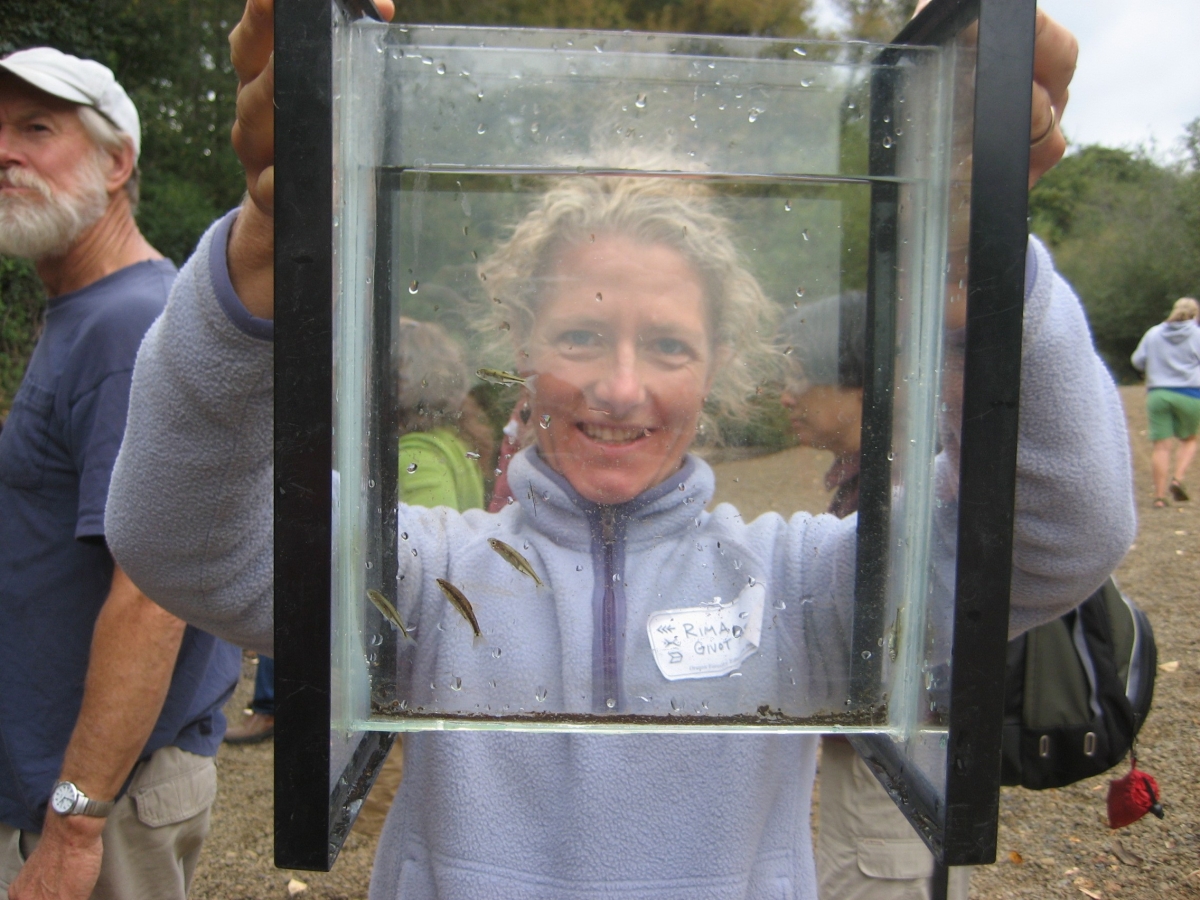 Rima Givot
Rima Givot
In 2009, Rima Givot, a biology, geology, and astronomy teacher at Sisters High School, shadowed different researchers at the H.J. Andrews Experimental Forest LTER site. With the intent to gain experience and ideas for implementing field science inquiry projects into her teaching, she interviewed scientists and field assistants, assisted in field research, and visited different field sites. Working under Elizabeth Borer and Eric Seabloom, Givot assisted with field research and data collection for the Nutrient Network (NutNet) study. She learned about collection methods of biomass and invertebrates as well as improving plant identification techniques. She wrote lesson plans about plant identification and collection, and contributed a written overview of the NutNet project at a level that high school students could comprehend. Givot also worked with Andrews Forest researcher Jay Sexton and developed long term decomposition studies to conduct in a local forest with her biology classes.
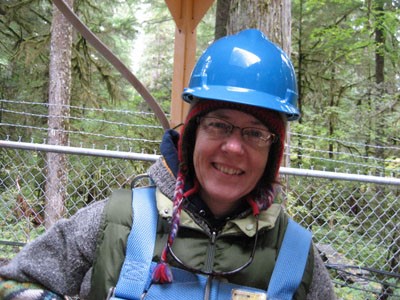 Jill Semlick
Jill Semlick
In 2008, Jill Semlick, a high school biology and ecology teacher at the Pauling Academy in Portland, Oregon, participated in the NSF-funded program, Research Experience for Teachers, at the Andrews Forest. Semlick shadowed six Andrews Forest researchers as they did their field work. She took video and still images which she wove together into several presentations titled "How Biologists 'Do' Biology." In her classroom, Semlick shares a video with her students each week. The students take away ideas to use in their own flying squirrel study project. Semlick reported, "My students enjoy and request the presentations, I think because they make science accessible to them. They see their teacher (me) in the role of student, doing an assignment, which ultimately makes them consider science, college and research as viable personal goals."
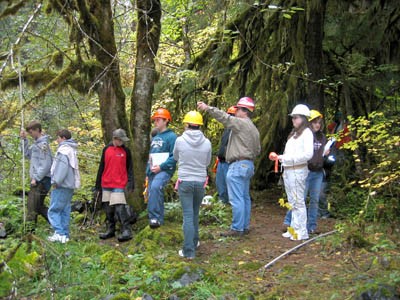 Kurt Cox
Kurt Cox
In 2006, Kurt Cox, a junior high science teacher from the McKenzie River School District, developed a set of research activities on the McKenzie River high school grounds which are based upon the research being conducted at the Andrews Forest LTER site. The seventh and eighth-graders visited the H.J. Andrews Experimental Forest LTER site for two days in the fall and spring to collect data for comparison to that collected on the high school grounds.
 Larry Byman
Larry Byman
In 2006, Larry Byman, a Biology and Environmental Field Studies teacher in Longview, Washington, worked with Andrews Scientists during the 2006 field season to learn about long-term data collection and data management techniques. Based on what he learned at the Andrews, Byman developed an environmental curriculum for use at the Longview District's Wake Robin Outdoor Learning Center. "This ranks as one of the absolute best learning experiences I've had during my teaching career," said Byman. His lessons covered topics such as Litter Decomposition, Moth Diversity, Soil Seed Bank, Stream Cross Section, and Tree Growth Rate.
Dan Bregar
In 2005, Dan Bregar, a Biology, Ecology, Physical Science, and Computer Technology teacher in Corvallis, Oregon, investigated the growing role of GIS in ecological research. With the help of the Andrews Forest Spatial Data Manager, Bregar and his Advanced Field Biology students learned how to use GIS with their field data. They collected GPS points and matched them with existing spatial data for their study sites. Bregar developed curriculum that involved hands-on units to teach proper field techniques for GIS use, along with a series of on-line and conventional lessons that taught students how to use GIS software to enter, display, and analyze ecological data.
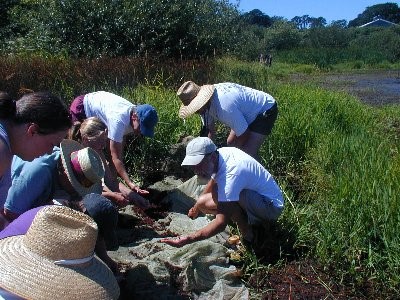 Jeff Mitchell
Jeff Mitchell
In 2003, Jeff Mitchell of Philomath, Oregon worked with Andrews Forest scientists Sherri Johnson and Andy Moldenke to investigate the effects of forest harvest on the diversity and abundance of invertebrates in soil, water, and air. From these experiences, Mitchell developed field activities for his high school biology classes in a 75-acre wetland in Philomath. The students used scientific protocols Mitchell learned as an RET to sample different parts of the food chain (aquatic invertebrates, small mammals, etc.), analyze the data, and discuss which species are native v. introduced. In 2004, through a proposal to SEPS (Science Education Partnerships), Mitchell taught a Wetlands Field biology Workshop, in which 13-14 teachers participated for a week. Five of his students helped with the teacher workshop.
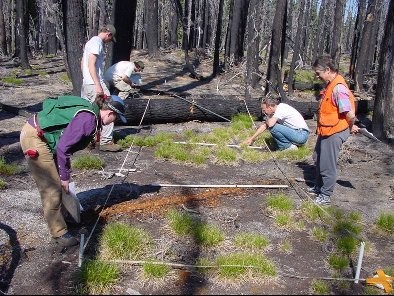 Lyn Neeley
Lyn Neeley
In 2003, Lyn Neeley, who teaches biology in New York City at East Side Community High School, worked with Andrews Forest scientist Kari O'Connell on several long-term forest carbon studies at the Andrews Forest and on wildfire research in the Torrey Charlton Research Natural Area. Neeley developed a series of Powerpoint presentations and student activities based on the Andrews Forest ecosystem that she uses as the ecology unit in 9th and 10th-grade biology classes.

